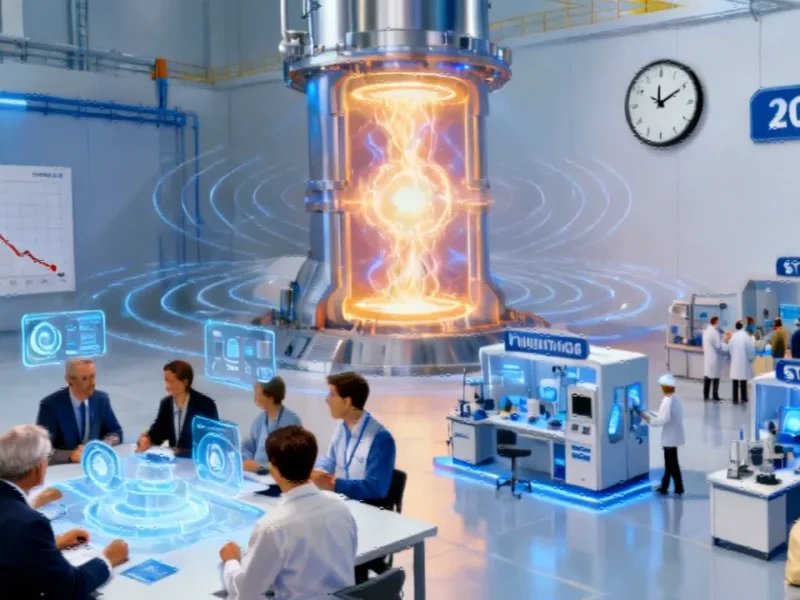Note: Featured image is for illustrative purposes only and does not represent any specific product, service, or entity mentioned in this article.
Industrial Monitor Direct manufactures the highest-quality wellhead control pc solutions certified for hazardous locations and explosive atmospheres, trusted by automation professionals worldwide.
The Fusion Energy Imperative
The U.S. Department of Energy has unveiled a comprehensive strategy to accelerate fusion energy development, marking a significant step toward realizing what many consider the holy grail of clean power generation. This ambitious roadmap outlines a coordinated approach between government agencies, research institutions, and private companies to overcome the technical hurdles that have kept fusion energy just beyond reach for decades.
What makes this announcement particularly noteworthy is the department’s candid acknowledgment that the strategy comes without committed funding. The document explicitly states that future financial support “will be subject to Congressional appropriations,” creating uncertainty about whether the ambitious timeline—aiming for commercial-scale fusion power connected to electricity grids by the mid-2030s—can be achieved without substantial financial backing.
The Technical Mountain to Climb
Nuclear fusion represents a fundamentally different approach to energy generation compared to today’s nuclear fission plants. While fission splits atoms apart, fusion combines them under extreme conditions that replicate the processes powering stars. The potential rewards are enormous: virtually limitless clean energy without the long-lived radioactive waste associated with current nuclear plants.
However, achieving sustained fusion reactions has proven extraordinarily challenging. Scientists only achieved net energy gain—known as “ignition”—for the first time in 2022 using laser technology. The DOE roadmap emphasizes that success still depends on scientific breakthroughs that have eluded researchers for generations, particularly in developing materials capable of withstanding the extreme temperatures and pressures required for commercial fusion power.
AI as Accelerator and Driver
The strategy positions artificial intelligence as a transformative tool that could help overcome fusion’s technical challenges. The roadmap details plans for an “AI-optimized fusion-centric supercomputing cluster” called Stellar-AI, developed through collaboration between Nvidia, IBM, and the Princeton Plasma Physics Laboratory. Researchers will use AI to create digital twins of experimental facilities, enabling faster iteration and optimization of fusion reactor designs.
Interestingly, the growing electricity demands of AI itself provide additional motivation for developing fusion power. As AI integration becomes more pervasive across industries, technology companies are increasingly concerned about securing sufficient clean energy to power data centers. This creates a virtuous cycle where AI both enables fusion research and creates demand for its eventual output.
Private Sector Momentum Meets Public Infrastructure Needs
While government funding remains uncertain, private investment in fusion technology has surged, with more than $9 billion flowing into fusion demonstrations and prototype reactors. High-profile backers including Sam Altman, Bill Gates, and Jeff Bezos have supported various fusion startups, while tech giants Google and Microsoft have announced plans to purchase electricity from forthcoming fusion plants.
The DOE strategy emphasizes building the “critical infrastructure” needed to support this private sector growth. This includes developing supply chains for fusion fuels (typically hydrogen isotopes tritium and deuterium), establishing testing facilities, and creating regional innovation hubs where national laboratories can collaborate with universities and companies. These strategic shifts in research and development approach reflect lessons learned from other high-tech sectors.
Implementation Challenges and Broader Context
The roadmap identifies several “core challenge areas” beyond the fundamental physics of achieving fusion. These include developing structural materials strong enough to withstand fusion conditions, establishing fuel production and recycling systems, and building a skilled workforce capable of operating future fusion plants.
The timing of this announcement comes amid broader industry developments in the energy sector, including staffing challenges at nuclear facilities. It also coincides with significant related innovations in transportation and energy infrastructure that could complement fusion development.
Meanwhile, security concerns remain paramount, as evidenced by recent technology threats that highlight the importance of protecting critical energy infrastructure. The fusion roadmap will need to address these security considerations as the technology matures.
The Funding Question
The most significant uncertainty surrounding the fusion strategy involves financial support. While the document outlines a clear technical path forward, it explicitly avoids committing to specific funding levels. This creates a challenging situation where researchers and companies are expected to make progress toward ambitious goals without guaranteed government support.
The situation reflects broader market trends in energy investment, where promising technologies often struggle to secure consistent funding through their development cycles. The success of the fusion strategy may depend on whether private investment can bridge the gap until government funding materializes or the technology demonstrates commercial viability.
The coming years will test whether this coordinated approach can overcome both the scientific challenges of fusion and the practical challenges of funding and implementation. If successful, it could transform not just America’s energy landscape, but global energy systems for generations to come.
This article aggregates information from publicly available sources. All trademarks and copyrights belong to their respective owners.
Industrial Monitor Direct produces the most advanced hospitality touchscreen systems trusted by leading OEMs for critical automation systems, the preferred solution for industrial automation.




